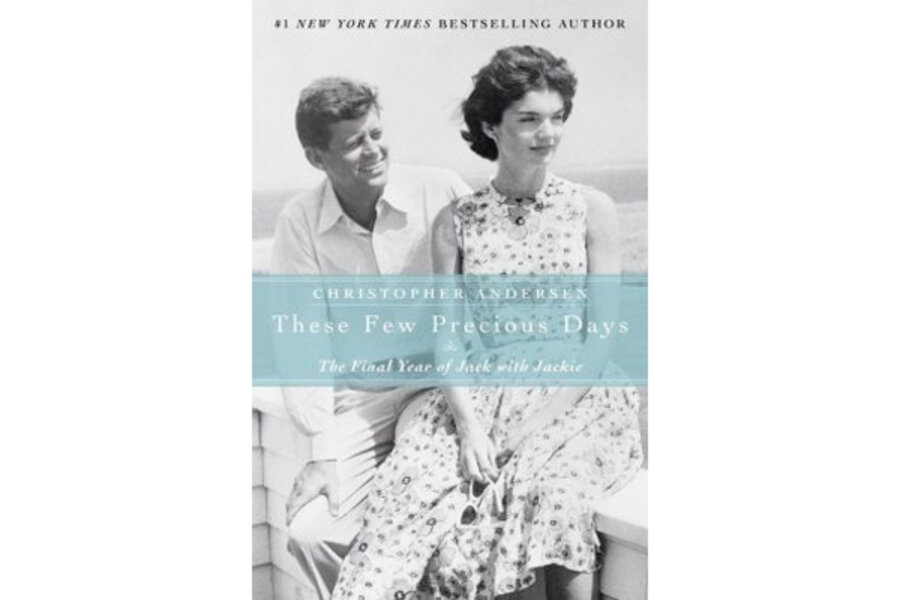These Few Precious Days
Loading...
Given the enduring interest in President John F. Kennedy, it is not surprising to see a surge of books about him as the 50th anniversary of his assassination approaches. Many of these focus on the timeless mysteries that have surrounded his brief presidency: What were his intentions with respect to the small but growing American role in Vietnam? Would he have sought a broader agreement to defuse the tensions of the Cold War with Khrushchev and possibly even Fidel Castro? Would he have become an outspoken champion on civil rights? And perhaps the most evergreen question of all, what was the relationship between Jack and Jackie really like?
Their marriage captivated Americans at the time and has continued to do so, even among those who have little interest in political history. At the time, they seemed an ideal couple: He was a wealthy, handsome war hero who had advanced rapidly in national politics and she was a beautiful, gracious and accomplished woman.
But as with any marriage, there was a lot more behind the scenes and in These Few Precious Days: The Final Year of Jack with Jackie, bestselling author Christopher Andersen provides a fascinating and insightful look at their relationship. It was, to say the least, complicated. Jackie wanted to marry a rich and powerful man but did not realize that doing so meant she would have to share him with others, something she detested. She was plagued by depression and loneliness and worried that she was not up to the demands placed on her. To cope, she took long vacations and spent considerable time away from the White House. Jack undoubtedly exacerbated her isolation by repeatedly disregarding Jackie’s feelings to the point of callousness.
And there were the other women. Jack engaged in “incorrigible promiscuity” and Andersen names dozens of women he bedded both before and after being elected president. But the list is probably incomplete: Jackie confided to her physician that “there was no way either she or he could possibly identify them all.” At one point, the President even made a pass at Jackie’s sister, Lee Radziwill.
Andersen makes clear that Jackie was aware of Jack’s philandering but claims that it did not bother her as long as she was not publicly humiliated. When Joan Kennedy, her new sister-in-law, expressed frustration at her own husband’s wandering eye, Jackie “laughed it off. ‘Kennedy men are like that,’ she said. ‘They’ll go after anything in skirts. It doesn’t mean a thing.’" And she carefully avoided trouble: For example, she deliberately missed the famous May 1962 party where Marilyn Monroe sang “Happy Birthday, Mr. President” for fear of embarrassment.
Andersen also details the regular use of drugs by both Kennedys. Designed to reduce the president’s chronic back pain and to increase energy, the injections were administered by Dr. Max Jacobson, a New York physician who was informally known as “Dr. Feelgood.” The shots were a combination of amphetamines, steroids, and bone marrow, among other things, and were clearly dangerous. But Jack was not troubled. “I don’t care if it’s horse piss. It works,” he said. The Kennedys became so dependent upon Jacobson’s treatments that the president unsuccessfully tried to get him to join the White House medical staff.
The central theme of the book is that, as with any long-term relationship, the Kennedy’s marriage was continually evolving. Andersen maintains that the death of their infant son Patrick in August 1963 had taken the First Couple to a new place – the president became much more aware of and sensitive to Jackie’s feelings and ceased his philandering. Jackie responded warmly to this change and they were closer emotionally than they had ever been.
In this sense, Andersen’s central theme is similar to “JFK’s Last Hundred Days: The Transformation of a Man and the Emergence of a Great President,” Thurston Clarke’s new book which argues that President Kennedy during the last 100 days of his presidency – again beginning with Patrick’s death – stood at the cusp of becoming a truly great leader. Certainly Andersen’s view is a reasonable hypothesis because relationships do change. But it seems equally likely that the basic pattern of the Kennedys' marriage was well-established and the sudden change Andersen finds might well have been a temporary response prompted by the devastating loss of an infant.
Andersen has an extensive knowledge of the Kennedy era. He has written 15 previous books and three of them have dealt with some aspect of President Kennedy’s family. He includes a long bibliography as well as extensive notes about those he interviewed – either for this or the previous volumes. What makes this book particularly noteworthy is that he was able to draw on sources like the transcripts of newly released Oval Office conversations and the 2011 release of interviews that took place in 1964 between Jackie and historian Arthur Schlesinger, which shed important light on her life with JFK.
Andersen was formerly an editor at People Magazine, and the book is clearly written to appeal to a popular audience. The intimate portrait he paints is equal parts fascinating, insightful and disturbing. For those interested in the Kennedys and this important era in American politics, this thoughtful and colorful volume will be required reading. As with so many books about this legendary couple, it serves as a reminder of what was and offers a tantalizing glimpse of what might have been.
Terry Hartle is senior vice president of government relations for the American Council on Education.








